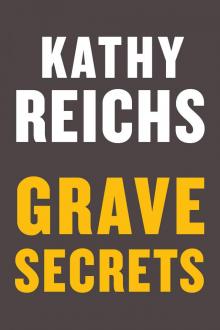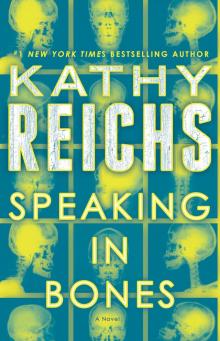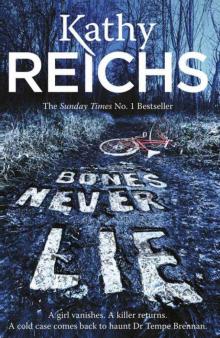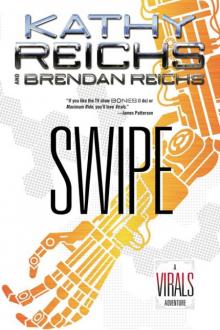- Home
- Kathy Reichs
Deadly Descisions Page 12
Deadly Descisions Read online
Page 12
Claudel read from the printout. "She was reported missing in May of 1984, two weeks after her sixteenth birthday"
"That was a quick turnaround," I said, digesting the information.
"0h."
I waited, but he did not go on. I kept the annoyance from my voice.
"Monsieur Claudel, any information you have will help me confirm this ID."
A pause. Then, "The shunt and the dentals were unique so the computer spit the name right out. I called the Shalotte PD and actually talked to the reporting officer According to her, the mother got the case entered, then dropped it cold. There was the usual media frenzy at first, then things died down. The investigation went on for months, but nothing ever turned up."
"Troubled kid?"
A longer pause.
"There is no history of drug or discipline problems. The hydrocephaly caused some learning disabilities and affected her eyesight, but she wasn't retarded. She went to a normal high school and did well. She was never considered a potential runaway.
"But the child was hospitalized frequently because of problems with the shunt. Apparently the apparatus would get blocked and they'd have to go in and fix it. These episodes were preceded by periods of lethargy, headache, sometimes mental confusion. One theory is that she became disoriented and wandered of f."
"Off what, the planet? What's the other theory?"
"The father."
Claudel flipped open a small spiral notebook.
"Dwayne Allen Osprey. A real charmer with an arrest record longer than the Trans-Siberian Railway. Back then Dwayne's domestic routine revolved around drinking Jim Beam and beating up his family. According to the mother's original statement, which she later retracted, her husband always disliked Savannah, and things got worse as the child grew older. It wasn't beyond him to slam her into a wall. Seems Dwayne found his daughter a disappointment. Called her Water Brain."
"They think he murdered his own daughter?"
"It's a possibility. Whiskey and rage are a deadly cocktail. The theory was that things got out of hand, he killed her, then disposed of the body"
"How did she end up in Quebec?
"An insightful question, Dr Brennan."
With that he rose and shot the cuffs on the crispest, whitest shirt I'd seen in decades. I gave him a drop-dead-peckerhead lock, but he was already out the door.
I sighed and leaned back in my chair.
You bet your prim little ass it's an insightful question, Monsieur Claudel.
And I'm going to answer it.
Chapter 17
I took a deep breath. As usual, Claudel had made me furious.
When I felt calmer, I looked at my watch. Four-forty It was late, but maybe I could catch her
Checking my Rolodex, I dialed SBI Headquarters in Raleigh. Kate Brophy picked up on the first ring.
"Hi, Kate. It's Tempe."
"Hey, girl, are you back in Dixie?"
"No. I'm in Montreal."
"When are you going to get your skinny tail down here so we can tip a few?"
"My tipping days are over, Kate."
"Oops. Sorry. I know that."
Kate and I had met at a time when I was as committed to alcohol as a college freshman on spring break. Only I wasn't eighteen and I wasn't at the beach. Past thirty, I was then a wife and mother, and a university professor with exhausting teaching and research responsibilities.
I never noticed when I joined the rank of brothers and sisters in denial, but somewhere along the way I became a champion rationaiizer A glass of Merlot at home in the evening. A beer after classes. A weekend party I didn't need the booze. I never drank alone. I never missed work. It wasn't a problem.
But then the glass became a bottle, and the late-night binges required no company. That's the beguiling thing about Bacchus. He has no entrance fee. No minimum drink order. Before you know it you're in bed on a sunny Saturday afternoon while your daughter plays soccer and other parents cheer.
That show had closed down, and I wasn't about to re-raise the curtain.
"It's funny you called," said Kate. "I was just talking to one of our investigators about the biker boys you glued together back in the eighties."
I remembered those cases. Two entrepreneurs had made the mistake of dealing drugs on turf claimed by the Hells Angels. Their body parts were found in plastic bags, and I'd been asked to sort dealer A from dealer B.
That foray into fresh forensics had been a catalyst for me. Until then I'd worked with skeletons unearthed at archaeological sites, examining bones to identify disease patterns and estimate life expectancies in prehistoric times. Fascinating, but minimally pertinent to current events.
When I began consulting to the North Carolina medical examiner, I felt an excitement not present in my early work. Kate's bikers, like the cases that followed, had an urgency that ancient deaths did not. I could give a name to the nameless. I could provide a family with closure. I could contribute to law enforcement's efforts to reduce the slaughter on America's streets, and to identify and prosecute perpetrators. I'd shifted my professional focus, gone dry in my personal life, and never looked back on either front.
"How did you end up in Tulio's case review session?" Tasked.
"I drove a couple of my analysts up to Quantico for a VICAP training session. Since I was there, I decided to sit in to see what's new
"What was?"
"Other than the fact that your biker boys are knocking each other off with greater alacrity than most social clubs, looks like the same old."
"I don't think I've worked a Carolina biker case in years. Who's down home these days?"
"We've still got three of the big four."
"Hells Angels, Outlaws, and Pagans."
"Yes, ma'am. No Banditos yet. And it's been quiet for some time, but you never know. Things could heat up next month when the Angels hold their run at Myrtle Beach."
"It's still pretty wild up here, but that's not why I'm calling."
"Oh?"
"Ever hear of a young girl named Savannah Claire Osprey?"
There was a long silence. Across the miles the connection sounded like the ocean in a seashell.
"Is this a joke?"
"Absolutely not."
I heard her take a deep breath.
"The Osprey disappearance was one of the very first cases I worked for the bureau. It was years ago. Savannah Osprey was a sixteen-year-old kid with a lot of medical problems. Didn't hang with a wild crowd, didn't do drugs. One afternoon she left her house and was never seen again. At least that was the story.
"You don't believe she ran away?"
"The local police suspected the father, but no one could find a thing to prove it.
"Do you think he was involved?"
"It's possible. She was a timid kid, wore thick glasses, rarely went out, didn't date. And it was common knowledge the old man used her for a punching bag." Her voice was filled with contempt. "The guy should have been locked up. Actually he was, but not until later. Got busted on a drug charge, I think. Died about five years after his daughter disappeared."
What she said next hit me like a blow to the chest.
"He was such a peckerwood shit and she was such a pathetic little thing that the case really bothered me. I've kept her bones all these years."
"What did you say?" I gripped the phone, barely breathing.
"The parents never accepted it, but I know they're hers. I still have them stored at the ME office. Doc calls every now and then, but I always ask him to hang on to the stuff"
"Her remains were found?"
"Nine months after Savannah disappeared a female skeleton turned up near Myrtle Beach. That was the thing that shined the light on Dwayne Osprey. While he was never what you'd call a steady worker, around the time she went missing he was making deliveries for a local cheesecake company. The day of his daughter's disappearance Daddy made a trip to Myrtle Beach."
I was so shocked I could hardly formulate a question.
> "But did you ever get a positive on the remains?"
"No. There was too much missing and what was recovered was too damaged. And of course we weren't doing DNA back then. Why are you asking about Savannah Osprey?"
"Did you recover a skull?"
"No. That was the main problem. The victim had been dumped in the woods then covered by a sheet of corrugated tin. Animals pulled parts of the body out and scattered them all over creation. The skull and jaw were never found, and we figured they'd dragged them off. The bones left under the tin were intact but weren't very useful, and the rest of the skeleton was so badly chewed that it was hard to tell much except gender. Some pathologist was doing the anthropology back then. His report stated that nothing remained to indicate age, height, or race.
A pathologist would not have known about microscopic aging, or about calculation of stature from partial long bones. Not a good job, Doc.
"Why do you think it's Savannah?" I asked.
"We found a small silver charm in the vicinity of the bones. It was a bird of some sort. Though she denied it, I could tell from the mother's reaction that she recognized the thing. Later I did some research. The charm was an exact replica of a fish hawk."
I waited.
"The fish hawk is also known as the osprey."
I told her about the skull and leg bones in Montreal.
"Holy shit."
"Is the mother still around?"
"Anything's possible since they cloned that sheep. I'll find out." "Do you still have the file?"
"You bet."
"Antemortem X rays?"
"Zillions."
I made a quick decision.
"Get those bones, Kate. I'm coming down."
Patineau authorized the trip, and I booked a morning flight to Raleigh. Kit and I had a late dinner that night, both of us avoiding mention of the bundle in the entrance hall that I had brought from the lab and would be taking with me. He was looking forward to tomorrow s outing with Crease and had no problem with my absence.
The plane was crowded with the usual assortment of students, businessmen, and weekend golfers. I stared out the window as attendants served coffee and soft drinks, wishing I, too, were off to a course-Pinehurst, Marsh Harbor, Oyster Bay, anything but the grim analysis of a teenage girl's bones.
My eyes dropped to the athletic bag under the seat in front of me. It looked innocuous enough, but I wondered what my fellow passengers would think if they knew the nature of its contents. I have flown out of Dorval often enough that the X-ray machine operators no longer ask for an explanation. I wondered how it would be leaving Raleigh.
Outside, the morning sun was painting the clouds a luminescent pink. When we broke through I could see a tiny shadow plane paralleling the one in which I rode.
Yes, that was it, I thought. That's how I saw the girl at my feet. Though I now had a name, in my mind's eye she remained a shadowy ghost on a formless landscape. I hoped this trip would change that image into a firm identification.
Chapter 18
Kate met me at the Raleigh-Durham Airport and we drove directly to the SBJ lab. She'd already brought the remains from the medical examiner's office in Chapel Hill, and secured a room where we could work. If samples were to be taken for DNA analysis, all parties agreed that this arrangement was the most efficient.
I gloved my hands and unwrapped my parcel as Kate retrieved hers from a locked closet. She placed a long white box on the table and stepped away. I could feel the familiar tension in my chest as I unwound the string and folded back the cardboard flaps.
One by one I arranged the bones, placing each in its correct anatomical position. Ribs. Vertebrae. Pelvis. Long bones.
The pathologist had been right in his assessment of animal damage. Scavengers had gnawed away so much that not a border, crest, or joint remained on any but the smallest bones. The pubic symphyses and iliac crests were completely gone, and only fragments of clavicle had survived. But one fact was immediately clean
Both femora were missing.
I added the bones from St-Basile to those that lay on the table. While they did not complete the skeleton, neither did they duplicate any element.
Kate spoke first.
"Looks like a match for size and muscular development. She must have been a tiny thing."
"Using a femur I calculated a height of five foot two, plus or minus. Let's see what your tibia gives us." I indicated two landmarks on the shaft. "There's a regression formula that allows the use of just this segment."
I took the measurement then did the math. The error range was large but bracketed the estimate I'd gotten with the femur. When I showed her the figure, Kate went to the side counter and riffled through a file that was thicker than a Manhattan phone book.
"Here it is. Savannah was five-one and three-quarter inches."
She riffled some more, then withdrew a five-by-seven envelope and shook free several pictures. She spoke as she studied an image.
"It was so sad. Most of Savannah's classmates had no idea who she was. And Shallotte is not that big a place. The kids that did recognize her name or photo couldn't tell us a thing about her. She was one of those people that no one remembers. Born 1968. Died 1984."
Kate held out a snapshot.
"The kid got a really bum deal. Miserable family. No friends. Anyway, you can tell she wasn't very big."
I looked at the photo and felt a surge of pity.
The girl sat on a blanket, one scarecrow arm clutching her middle, the other held palm out to fend off the picture taker. She wore a one-piece bathing suit that showed skin so pale it was almost blue. She'd been hiding her face, but the camera caught her looking up, eyes enormous behind thick lenses. In the distance I could make out the horizontal slash of waves meeting shore.
As I stared at the wan little face, I ached inside. What could have prompted an attack on someone so fragile? Did a stranger force her at knifepoint, then strangle and leave her to the dogs? When did she realize she was going to die? Did she scream in terror, knowing no one would hear her cries? Had she died in her own home, to be hauled off and dumped? As her eyes closed for the last time did she feel terror or resignation or hatred or numbness, or merely bewilderment? Had she felt pain?
"Compare cranial features."
Kate was pulling X rays from a large brown envelope and popping them onto a wall illuminator
"This is a cranial series taken just four months before Savannah disappeared."
I got my X rays from the athletic bag and clipped them next to the hospital films. Starting with the facial views, I compared the shape of the frontal sinuses. Varying from small and simple to large and multichambered, these hollow spaces above the orbits are as unique to an individual as his or her fingerprints.
Savannah's sinuses rose into her forehead like a crest on the head of a cockatoo, the configuration on her hospital X rays matching exactly the one in the skull on my film. And the surgical burr hole was clearly visible in every view, the shape and position identical on the antemortem and postmortem films.
There was no doubt that the skull unearthed in St-Basile was Savannah Claire Osprey. But could we link the skull and femora to the partial skeleton found near Myrtle Beach?
Before leaving Montreal I'd removed a sliver of bone from the shaft of one of the femora and extracted a molar from the upper jaw in the skull, thinking that if relatives could be located, or antemortem samples of the victim's tissue or blood could be recovered, DNA sequencing might confirm the suspected identity. While the dental and radiographic evidence now rendered DNA testing unnecessary for purposes of identifying the bones from Montreal, I had another goal in mind.
Using a bone saw, I cut a one-inch chunk from all of the tibiae and fibulae that Kate had been saving all these years. She watched in silence as the circular blade buzzed through the dry bone, sending up a powdery white spray
"It's not likely the hospital will come up with samples after all this time."
"No," I agreed.
"But it happens."
It was true. Gallstones. Pap smears. Blood spots. Old DNA had been found in all sorts of strange places.
"What if there are no relatives?"
"By comparing the sequencing from the Myrtle Beach bones to that found in the St-Basile-le-Grand bones we'll at least know if all the remains come from the same individual. If they do we have essentially identified the Myrtle Beach bones because we have a firm ID on the Montreal skull. But I would like to get a DNA."
"What if there's no DNA?"
"I've already had microscope slides made from one of the St. Basile thigh bones. When I get back I'll do the same with these samples, then I'll examine everything under high-powered magnification."
"What will that tell you?"
"Age, for one thing. I'll see if that's consistent between the two sets of remains. I'll also look for details in microstructure that might be useful."
It was almost one when we'd labeled and numbered the four specimens and Kate had done the paperwork necessary to release them to me. We decided to grab a quick lunch before tackling the case file. Over cheeseburgers and fries at the local Wendy's she related what was known of Savannah Osprey's last hours.
According to the parents, Savannah had had a routine week. Her health was good and she was looking forward to an event at her school, though they couldn't remember what it was. On the day of her disappearancc she spent the early afternoon studying for a math exam, but didn't appear particularly anxious about it. Around two she said she needed something at the drugstore, and left the house on foot. They never saw her again.
"At least that was Daddy's version," Kate concluded.
"He was at home that day?"
"Until around three-thirty, when he made a pickup in Wilmington, then set out for Myrtle Beach. The departure time was confirmed by his employer He showed up a little late with the delivery but blamed the delay on traffic."
"Were you able to search the house or truck?"
"Nope. We had nothing on him, so we could never get a warrant."
"And the mother?"
"Brenda. She's another piece of work."

 Two Nights
Two Nights The Bone Collection: Four Novellas
The Bone Collection: Four Novellas Fatal Voyage
Fatal Voyage 206 Bones
206 Bones Bones to Ashes
Bones to Ashes Terminal
Terminal Monday Mourning
Monday Mourning Flash and Bones
Flash and Bones Cross Bones
Cross Bones Devil Bones
Devil Bones Break No Bones
Break No Bones Swamp Bones
Swamp Bones Déjà Dead
Déjà Dead Shock
Shock Spider Bones
Spider Bones Death Du Jour
Death Du Jour Grave Secrets
Grave Secrets Trace Evidence: A Virals Short Story Collection
Trace Evidence: A Virals Short Story Collection Bones on Ice
Bones on Ice The Bone Code
The Bone Code Bones in Her Pocket
Bones in Her Pocket Seizure:
Seizure: Speaking in Bones
Speaking in Bones Deadly Decisions
Deadly Decisions Spike
Spike Bones Never Lie
Bones Never Lie Bones of the Lost
Bones of the Lost Virals 03.5 - Swipe
Virals 03.5 - Swipe Exposure
Exposure A Conspiracy of Bones
A Conspiracy of Bones Shift (tory brennan)
Shift (tory brennan) Bones of the Lost: A Temperance Brennan Novel tb-16
Bones of the Lost: A Temperance Brennan Novel tb-16 Virals tb-1
Virals tb-1 Bones Are Forever tb-15
Bones Are Forever tb-15 Code tb-3
Code tb-3 Seizure tb-2
Seizure tb-2 Deadly Descisions
Deadly Descisions Spider Bones: A Novel
Spider Bones: A Novel